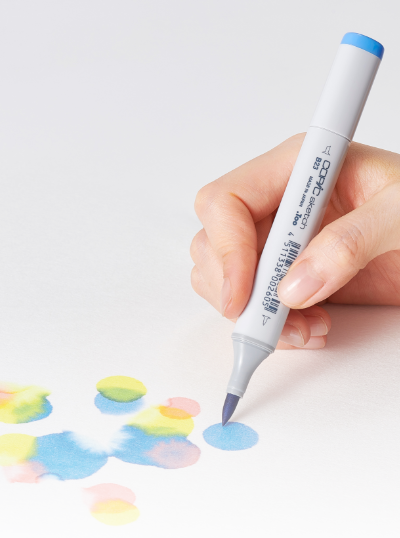Browns; How to Color Faces
30-06-2022
Using Earth-Tones to Color Human Skin
Today’s Feature: How to color faces

In this blog, we’ll be showing you how to choose skin-tones while coloring 9 different face shapes in the template below. The easiest way to get started coloring people is by getting the Sketch or Ciao 6 piece Portrait-tones set. You can create a lot of different skin-tones with just these 6 marker colors! However, in this blog, we’ll be going into more detail and give a variety of color combinations that encompass all types of skin-tones. And with that, let’s get started!

The template above includes some of the most common face shapes. Some of these shapes have a more pronounced chin, like the diamond, heart and inverted triangle. Some have a wider jaw-line, like the triangle, rectangle and square. Some have longer faces, like the oval and the oblong; while others have shorter faces, like the round. Each of these examples are just that though, examples. No two people are the same! But, with the help of these drawings, we hope to give you a starting-off point for your own practice and inspiration.
Now that we’ve introduced the different face shapes in the template, let’s get to the fun part: coloring with Copic! :)

Sometimes, the colors you think will look good together end up not being what you hoped for, so that’s why we recommend swatching out your colors first! A great way to establish a basic skin-tone palette is to have 1 dark, 1 mid-tone, and 1 light color. If you want to create a darker skin-tone, we recommend looking for Copic marker colors that end with a 7 or above, like E49, E57, or E27. If you want to create a mid-tone skin palette, then look for colors ending with 3 or above, like E25, E15, or E13. Lastly, for pale skin-tones, look for colors ending with 2 or below, like E02, E00, or YR30.

Now that we’ve made our color palettes, it’s time to start coloring the faces! What we recommend is to start off with your darkest color first. It may sound scary to start off with a dark color, but the reason we recommend this is because the lighter colors that will be used after them will lighten the dark color as they naturally blend together.
*Note: the above example has been colored using a light source coming from the front of each person. This is the most basic way to color, with direct lighting. The reason we mention this is because your shading will change depending on where your light source is coming from.

Now that your darkest color has been added to key areas of the face (under the chin, lips, nose, and brown-bone), the next color to add is the mid-tone. Be sure to leave a little bit of room around the areas of the forehead, cheeks, nose, neck, and clavicle for your final color, the lightest one!

And, with the lightest color added to each face, your coloring is almost complete! The next 2 steps are all about adding finishing touches to make your blending look more realistic.

You may not have noticed a lot of changes in the step above, and that’s because we added the small details of eye and lip colors! When choosing these colors, select ones that correspond with the skin color for a more natural effect. For example, in the heart face example, the eye color chosen was E57. For the oblong example, B34 was used. And in the triangle example, G21. The same principle was applied in choosing the lip colors as well. E04 was used for the darker skin-tone combinations and RV32 for the paler ones.
*Color Notes:
The eye colors used are E49, E57, E25, B37, B34, YG06, E23, B32, and G21 in order from the top left to the bottom right.
The lip colors used are E04 and RV32.

The final step to complete each of these faces is to add another layer of each color. That may sound like a lot of work, but we promise that the result of one more layer will be smoother blends and more contrast! Adding another layer is the best way to get rid of splotchy blends or any marker streaks you may have.

And with that, we wrap up this blog on how to color faces! Print out the sheet above at home on marker paper or premium cardstock (we recommend Neenah Bright White Premium Cardstock 65lb. or Neenah Exact Index Premium Cardstock 110lb.) and practice with as many Earth-Tone, Yellow-Red, Red, etc. colors as you’d like!
Be sure to share your lovely faces with us on social media using the hashtag #copicwithus and tag us @copic_official_us. We’d love to see your work!
—
In our next blog, we’ll be showing the basics on how to combine skin and hair colors, as well as choosing eye and lip colors for the face. Until then!
Read More Articles
Writing with Acrea, Pangrams
Greetings Copic readers! In our previous blog, we continued our introduction of writing with the new acrea marker by practicing our curs...

Writing with Acrea, Cursive Letters
Hello Copic readers! In our previous blog, we introduced writing with the new acrea marker by practicing our manuscript letterform...

Writing with Acrea, Manuscript Letters
Greetings Copic readers! In our previous blog, we compared the properties of Copic alcohol markers (Sketch, Ciao and Classic) with Copic...

Using Acrea and Copic Markers Together
Greetings Copic readers! In our previous blog, we compared the properties of Copic alcohol markers (Sketch, Ciao and Classic) with Copic...





